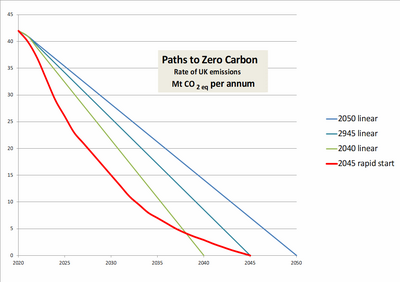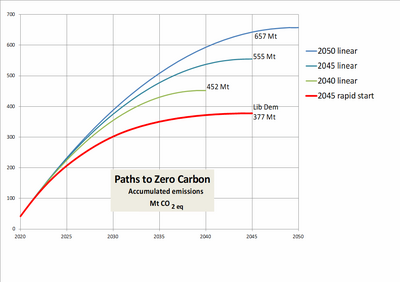Paths to Zero Carbon

In 2007, our Lib Dem policy paper 82, "Zero Carbon Britain - Taking a Global Lead", led the way by setting out how we would achieve net zero carbon emissions by 2050.
In the Coalition years Secretaries of State for Energy and Climate Change, Lib Dems Chris Huhne and then Ed Davey, were in constant battle with the Tory controlled Treasury, yet made significant progress towards our goal, and continued to do so until 2015.
More recent evidence suggests that global warming is getting closer than predicted to the temperatures that could trigger runaway change. However rather than speed up UK efforts; over the last four and a half years the Tories have let efforts slip back.
The amount of warming depends on the total amount of greenhouse gas in the atmosphere. The quicker the emission rate is reduced, the less greenhouse gases build up *2.

The LIB DEMS set up a working group to research what we need to do now, to catch up. The result was the 2019 Lib Dem Policy Paper 139, "Tackling the Climate Emergency", adopted at the recent Bournemouth Federal Conference, in motion F29. It is our plan to keep global warming below the critical value. This plans action for the first 100 days, and the rest of the first year, of a new Parliament, that will ensure a rapid fall in the rate of greenhouse gas emissions over a five year term. It stets bold targets for 2030 and 2040, leaving 2040 and 2045 to get down the difficult last 3% or so to get down to net zero emissions.
Various organisation have engaged in Zero Carbon Date shouting contests. They are meaningless. It is how quickly we get emissions falling that is critical.
Chart 1 shows uniformly (linearly) falling emissions from today's approximately 40 megatons CO2 equivalent greenhouse gases per annum - to zero by 2035, 2045 or 2050. The RED shows emissions falling most rapidly in the early years, as they might following the Lib Dem policy of a massive push for early reductions, with a latest zero carbon target of 2045
Chart 2 shows many mega-tons of CO2 equivalent greenhouse gases would accumulate by each of these paths. They show that a steady reduction to zero by 2040 would result in about 20% more emissions than a roughly Lib Dem style rapid start, with zero carbon by 2045.
Labour have a newly plucked from the breeze a zero carbon target of 2030. If it were possible to steadily reduce net greenhouse gas emissions to zero in just 10 years there would be only 226 megatons emitted in total, BUT this is an IMPOSSIBLE target TO REACH. They are not ready to get started at the steady rate needed. I cannot see how starting slowly and trying to build up to an even faster rate to get to zero in only 10 years, could be done without inducing such falls in living standards and social disruption that Labour would be voted out of office at the following election.
[1 These calculations illustrate the effect of Zero carbon date the path shape. They do not pretend to be predictions of actual emissions.]
[* 2Just as when filling the bath, the water level reached is more sensitive to when you start turning the tap off, rather than whether you give the tap a final hard screw, to stop the drips, one minute later or two.]

